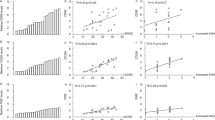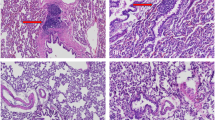Abstract
Our previous work showed that a Sca-1+ cell-based FGF2 therapy was capable of promoting robust increases in trabecular bone formation and connectivity on the endosteum of long bones. Past work reported that administration of FGF2 protein promoted bone formation in red marrow but not in yellow marrow. The issue as to whether the Sca-1+ cell-based FGF2 therapy is effective in yellow marrow is highly relevant to its clinical potential for osteoporosis, as most red marrows in a person of an advanced age are converted to yellow marrows. Accordingly, this study sought to compare the osteogenic effects of this stem cell-based FGF2 therapy on red marrow-filled lumbar vertebrae with those on yellow marrow-filled caudal vertebrae of young adult W41/W41 mice. The Sca-1+ cell-based FGF2 therapy drastically increased trabecular bone formation in lumbar vertebrae, but the therapy not only did not promote bone formation but instead caused substantial loss of trabecular bone in caudal vertebrae. The lack of an osteogenic response was not due to insufficient engraftment of FGF2-expressing Sca-1+ cells or inadequate FGF2 expression in caudal vertebrae. Previous studies have demonstrated that recipient mice of this stem cell-based FGF2 therapy developed secondary hyperparathyroidism and increased bone resorption. Thus, the loss of bone mass in caudal vertebrae might in part be due to an increase in resorption without a corresponding increase in bone formation. In conclusion, the Sca-1+ cell-based FGF2 therapy is osteogenic in red marrow but not in yellow marrow.
This is a preview of subscription content, access via your institution
Access options
Subscribe to this journal
Receive 12 print issues and online access
$259.00 per year
only $21.58 per issue
Buy this article
- Purchase on Springer Link
- Instant access to full article PDF
Prices may be subject to local taxes which are calculated during checkout








Similar content being viewed by others
References
Kalpakcioglu BB, Morshed S, Engelke K, Genant HK . Advanced imaging of bone macrostructure and microstructure in bone fragility and fracture repair. J Bone Joint Surg Am 2008; 90 (Suppl 1): 68–78.
Iwamoto J, Takeda T, Sato Y . Efficacy and safety of alendronate and risedronate for postmenopausal osteoporosis. Curr Med Res Opin 2006; 22: 919–928.
Spangrude GJ, Brooks DM, Tumas DB . Long-term repopulation of irradiated mice with limiting numbers of purified hematopoietic stem cells: in vivo expansion of stem cell phenotype but not function. Blood 1995; 85: 1006–1016.
Hall SL, Lau KH, Chen ST, Felt JC, Gridley DS, Yee JK et al. An improved mouse Sca-1+ cell-based bone marrow transplantation model for use in gene- and cell-based therapeutic studies. Acta Haematol 2007; 117: 24–33.
Montero A, Okada Y, Tomita M, Ito M, Tsurukami H, Nakamura T et al. Disruption of the fibroblast growth factor-2 gene results in decreased bone mass and bone formation. J Clin Invest 2000; 105: 1085–1093.
Hurley MM, Okada Y, Xiao L, Tanaka Y, Ito M, Okimoto N et al. Impaired bone anabolic response to parathyroid hormone in Fgf2-/- and Fgf2+/- mice. Biochem Biophys Res Commun 2006; 341: 989–994.
Mayahara H, Ito T, Nagai H, Miyajima H, Tsukuda R, Taketomi S et al. In vivo stimulation of endosteal bone formation by basic fibroblast growth factor in rats. Growth Factors 1993; 9: 73–80.
Liang H, Pun S, Wronski TJ . Bone anabolic effects of basic fibroblast growth factor in ovariectomized rats. Endocrinology 1999; 140: 5780–5788.
Nakamura K, Kurokawa T, Kawaguchi H, Kato T, Hanada K, Hiyama Y et al. Stimulation of endosteal bone formation by local intraosseous application of basic fibroblast growth factor in rats. Rev Rhum Engl Ed 1997; 64: 101–105.
Nakamura K, Kurokawa T, Aoyama I, Hanada K, Tamura M, Kawaguchi H . Stimulation of bone formation by intraosseous injection of basic fibroblast growth factor in ovariectomised rats. Int Orthop 1998; 22: 49–54.
Wronski TJ, Ratkus AM, Thomsen JS, Vulcan Q, Mosekilde L . Sequential treatment with basic fibroblast growth factor and parathyroid hormone restores lost cancellous bone mass and strength in the proximal tibia of aged ovariectomized rats. J Bone Miner Res 2001; 16: 1399–1407.
Lane NE, Kumer J, Yao W, Breunig T, Wronski T, Modin G et al. Basic fibroblast growth factor forms new trabeculae that physically connect with pre-existing trabeculae, and this new bone is maintained with an anti-resorptive agent and enhanced with an anabolic agent in an osteopenic rat model. Osteoporos Int 2003; 14: 374–382.
Yao W, Hadi T, Jiang Y, Lotz J, Wronski TJ, Lane NE . Basic fibroblast growth factor improves trabecular bone connectivity and bone strength in the lumbar vertebral body of osteopenic rats. Osteoporos Int 2005; 16: 1939–1947.
Iwaniec UT, Magee KA, Mitova-Caneva NG, Wronski TJ . Bone anabolic effects of subcutaneous treatment with basic fibroblast growth factor alone and in combination with estrogen in osteopenic ovariectomized rats. Bone 2003; 33: 380–386.
Power RA, Iwaniec UT, Wronski TJ . Changes in gene expression associated with the bone anabolic effects of basic fibroblast growth factor in aged ovariectomized rats. Bone 2002; 31: 143–148.
Fei Y, Xiao L, Hurley MM . The impaired bone anabolic effect of PTH in the absence of endogenous FGF2 is partially due to reduced ATF4 expression. Biochem Biophys Res Commun 2011; 412: 160–164.
Hall SL, Lau KH, Chen ST, Wergedal JE, Srivastava A, Klamut H et al. Sca-1(+) hematopoietic cell-based gene therapy with a modified FGF-2 increased endosteal/trabecular bone formation in mice. Mol Ther 2007; 15: 1881–1889.
Meng X, Baylink DJ, Sheng M, Wang H, Gridley DS, Lau KH et al. Erythroid promoter confines FGF2 expression to the marrow after hematopoietic stem cell gene therapy and leads to enhanced endosteal bone formation. PLoS One 2012; 7: e37569.
Hall SL, Chen ST, Gysin R, Gridley DS, Mohan S, Lau KH . Stem cell antigen-1+ cell-based bone morphogenetic protein-4 gene transfer strategy in mice failed to promote endosteal bone formation. J Gene Med 2009; 11: 877–888.
Hall SL, Chen ST, Wergedal JE, Gridley DS, Mohan S, Lau KH . Stem cell antigen-1 positive cell-based systemic human growth hormone gene transfer strategy increases endosteal bone resorption and bone loss in mice. J Gene Med 2011; 13: 77–88.
Pun S, Florio CL, Wronski TJ . Anabolic effects of basic fibroblast growth factor in the tibial diaphysis of ovariectomized rats. Bone 2000; 27: 197–202.
Lane NE, Yao W, Kinney JH, Modin G, Balooch M, Wronski TJ . Both hPTH(1-34) and bFGF increase trabecular bone mass in osteopenic rats but they have different effects on trabecular bone architecture. J Bone Miner Res 2003; 18: 2105–2115.
Nagai H, Tsukuda R, Mayahara H . Effects of basic fibroblast growth factor (bFGF) on bone formation in growing rats. Bone 1995; 16: 367–373.
Aguirre JI, Leal ME, Rivera MF, Vanegas SM, Jorgensen M, Wronski TJ . Effects of basic fibroblast growth factor and a prostaglandin E2 receptor subtype 4 agonist on osteoblastogenesis and adipogenesis in aged ovariectomized rats. J Bone Miner Res 2007; 22: 877–888.
Pun S, Dearden RL, Ratkus AM, Liang H, Wronski TJ . Decreased bone anabolic effect of basic fibroblast growth factor at fatty marrow sites in ovariectomized rats. Bone 2001; 28: 220–226.
Tanaka Y, Inoue T . Fatty marrow in the vertebrae. A parameter for hematopoietic activity in the aged. J Gerontol 1976; 31: 527–532.
Pittenger MF, Mackay AM, Beck SC, Jaiswal RK, Douglas R, Mosca JD et al. Multilineage potential of adult human mesenchymal stem cells. Science 1999; 284: 143–147.
Xiao L, Sobue T, Esliger A, Kronenberg MS, Coffin JD, Doetschman T et al. Disruption of the Fgf2 gene activates the adipogenic and suppresses the osteogenic program in mesenchymal marrow stromal stem cells. Bone 2010; 47: 360–370.
Martin I, Muraglia A, Campanile G, Cancedda R, Quarto R . Fibroblast growth factor-2 supports ex vivo expansion and maintenance of osteogenic precursors from human bone marrow. Endocrinology 1997; 138: 4456–4462.
Pitaru S, Kotev-Emeth S, Noff D, Kaffuler S, Savion N . Effect of basic fibroblast growth factor on the growth and differentiation of adult stromal bone marrow cells: enhanced development of mineralized bone-like tissue in culture. J Bone Miner Res 1993; 8: 919–929.
Fei Y, Xiao L, Doetschman T, Coffin DJ, Hurley MM . Fibroblast growth factor 2 stimulation of osteoblast differentiation and bone formation is mediated by modulation of the Wnt signaling pathway. J Biol Chem 2011; 286: 40575–40583.
Hurley MM, Lee SK, Raisz LG, Bernecker P, Lorenzo J . Basic fibroblast growth factor induces osteoclast formation in murine bone marrow cultures. Bone 1998; 22: 309–316.
Okada Y, Montero A, Zhang X, Sobue T, Lorenzo J, Doetschman T et al. Impaired osteoclast formation in bone marrow cultures of Fgf2 null mice in response to parathyroid hormone. J Biol Chem 2003; 278: 21258–21266.
Kawaguchi H, Chikazu D, Nakamura K, Kumegawa M, Hakeda Y . Direct and indirect actions of fibroblast growth factor 2 on osteoclastic bone resorption in cultures. J Bone Miner Res 2000; 15: 466–473.
Chikazu D, Hakeda Y, Ogata N, Nemoto K, Itabashi A, Takato T et al. Fibroblast growth factor (FGF)-2 directly stimulates mature osteoclast function through activation of FGF receptor 1 and p42/p44 MAP kinase. J Biol Chem 2000; 275: 31444–31450.
Zuo J, Jiang J, Dolce C, Holliday LS . Effects of basic fibroblast growth factor on osteoclasts and osteoclast-like cells. Biochem Biophys Res Commun 2004; 318: 162–167.
During A, Penel G, Hardouin P . Understanding the local actions of lipids in bone physiology. Prog Lipid Res 2015; 59: 126–146.
Nocka K, Tan JC, Chiu E, Chu TY, Ray P, Traktman P et al. Molecular bases of dominant negative and loss of function mutations at the murine c-kit/white spotting locus: W37, Wv, W41 and W. EMBO J 1990; 9: 1805–1813.
Geissler EN, Russell ES . Analysis of the hematopoietic effects of new dominant spotting (W) mutations of the mouse. I. Influence upon hematopoietic stem cells. Exp Hematol 1983; 11: 452–460.
Trevisan M, Yan XQ, Iscove NN . Cycle initiation and colony formation in culture by murine marrow cells with long-term reconstituting potential in vivo. Blood 1996; 88: 4149–4158.
Smith ER, Yeasky T, Wei JQ, Miki RA, Cai KQ, Smedberg JL et al. White spotting variant mouse as an experimental model for ovarian aging and menopausal biology. Menopause 2012; 19: 588–596.
Pachero R, Stock H . Effects of radiation on bone. Curr Osteoporos Rep 2013; 11: 299–304.
Chen ST, Gysin R, Kapur S, Baylink DJ, Lau KH . Modifications of the fibroblast growth factor-2 gene led to a marked enhancement in secretion and stability of the recombinant fibroblast growth factor-2 protein. J Cell Biochem 2007; 100: 1493–1508.
Peng H, Chen ST, Wergedal JE, Polo JM, Yee JK, Lau KH et al. Development of an MFG-based retroviral vector system for secretion of high levels of functionally active human BMP4. Mol Ther 2001; 4: 95–104.
Livak KJ, Schmittgen TD . Analysis of relative gene expression data using real-time quantitative PCR and the 2(-Delta Delta C(T)) Method. Methods 2001; 25: 402–408.
Farley JR, Hall SL, Herring S, Tarbaux NM . Two biochemical indices of mouse bone formation are increased, in vivo, in response to calcitonin. Calcif Tissue Int 1992; 50: 67–73.
Sheng MH, Amoui M, Stiffel V, Srivastava AK, Wergedal JE, Lau KH . Targeted transgenic expression of an osteoclastic transmembrane protein-tyrosine phosphatase in cells of osteoclastic lineage increases bone resorption and bone loss in male young adult mice. J Biol Chem 2009; 284: 11531–11545.
Acknowledgements
This work was supported in part by a Merit Review Entry Program grant from the Department of Veterans Affair Medical Research program. All work, except the irradiation procedure, was performed in facilities provided by the Department of Veterans Affairs.
Author information
Authors and Affiliations
Corresponding author
Ethics declarations
Competing interests
The authors declare no conflict of interest.
Rights and permissions
About this article
Cite this article
Lau, KH., Chen, ST., Wang, X. et al. Opposing effects of Sca-1+ cell-based systemic FGF2 gene transfer strategy on lumbar versus caudal vertebrae in the mouse. Gene Ther 23, 500–509 (2016). https://doi.org/10.1038/gt.2016.21
Received:
Revised:
Accepted:
Published:
Issue Date:
DOI: https://doi.org/10.1038/gt.2016.21



